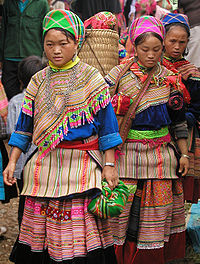
Hmong people

The Hmong people (RPA: Hmoob/Moob, Hmong pronunciation: ) are an ethnic group in East and Southeast Asia. They are a sub-group of the Miao people, and live mainly in Southern China, Vietnam and Laos. They have been members of the Unrepresented Nations and Peoples Organization (UNPO) since 2007.TaiIsan (Northeastern Thai) · Khorat Thai · Khün · Lao · Lao Ga · Lao Krang · Lao Lom · Lao Loum · Lao Ngaew · Lao Song · Lao Ti · Lao Wiang · Tai Lu · Northern Thai (Tai Yuan) · Nyong · Phu Thai · Phuan · Shan · Southern Thai · Tai Bueng · Tai Daeng (Red Tai) · Tai Dam (Black Tai) · Tai Gapong · Kaleun · Tai Nüa · Tai Wang · Thai (Central Thai)Other AustroasiaticBru · Chong · Kensiu (Maniq) · Khmer (Northern, Western) · Kintaq · Kuy · Mani (Negrito) · Mon · Nyah Kur (Chao-bon) · Nyeu · Pear · Sa'och · Aheu · VietnamesePalaungicBlang · Lamet · Lawa · Mok · Palaung (De'ang)Tibeto-BurmanAkha · Bamar · Bisu · Karen · Kayah (Red Karen) · Lahu · Lisu · Lolo (Yi) · Mpi · Pa'O · Phrae Pwo · Phunoi · Pwo · S'gaw · Ugong The Hmong people (RPA: Hmoob/Moob, Hmong pronunciation: ) are an ethnic group in East and Southeast Asia. They are a sub-group of the Miao people, and live mainly in Southern China, Vietnam and Laos. They have been members of the Unrepresented Nations and Peoples Organization (UNPO) since 2007. The Hmong (Miao) claim an origin in the Yellow River region of China. According to linguist Martha Ratliff, there is linguistic evidence to suggest that they have occupied some of the same areas of southern China for over 5,000 years. Evidence from mitochondrial DNA in Hmong–Mien–speaking populations supports the southern origins of maternal lineages even further back in time, although it has been shown that Hmong-speaking populations had comparatively more contact with northern East Asians than had the Mien. The ancient town of Zhuolu is considered to be the birthplace of the widely proclaimed legendary Hmong king, Chi You. Today, a statue of Chi You has been erected in the town. The author of the Guoyu, authored in the 4th to 5th century, considered Chi You’s Jui Li tribe to be related to the ancient ancestors of the Hmong, the San-Miao people. In 2011, White Hmong DNA was sampled and found to contain 7.84% D-M15 and 6%N(Tat) DNA. The researchers posited a genetic relationship between Hmong-Mien peoples and Mon-Khmer people groups dating to the Last Glacial Maximum approximately 15-18,000 years ago. Conflict between the Hmong of southern China and newly arrived Han settlers increased during the 18th century under repressive economic and cultural reforms imposed by the Qing Dynasty. This led to armed conflict and large-scale migrations well into the late 19th century, the period during which many Hmong people emigrated to Southeast Asia. The migration process had begun as early as the late-17th century, however, before the time of major social unrest, when small groups went in search of better agricultural opportunities. The Hmong people were subjected to abuse and killing by the Qing Dynasty government. Kim Lacy Rogers wrote: 'In the eighteenth and nineteenth centuries, while the Hmong lived in south-western China, their Manchu overlords had labeled them 'Miao' ('barbarian' or 'savage') and targeted them for genocide when they defied being humiliated, oppressed, and enslaved.' Since 1949, Miao has been an official term for one of the 55 official minority groups recognized by the government of the People's Republic of China. The Miao live mainly in southern China, in the provinces of Guizhou, Hunan, Yunnan, Sichuan, Guangxi, Hainan, Guangdong, and Hubei. According to the 2000 censuses, the number of 'Miao' in China was estimated to be about 9.6 million. The Miao nationality includes Hmong people as well as other culturally and linguistically related ethnic groups who do not call themselves Hmong. These include the Hmu, Kho (Qho) Xiong, and A Hmao. The White Miao (Bai Miao) and Green Miao (Qing Miao) are Hmong groups. A number of Miao lineage clans are also believed to have been founded by Chinese men who had married Miao women. These distinct Chinese-descended clans practice Chinese burial customs instead of Hmong style burials. In Sichuan, they were known as 'Chinese Hmong' ('Hmong Sua'). The Hmong were instructed in military tactics by fugitive Chinese rebels. Chinese men who had married into Hmong clans have established several Hmong clans. Chinese 'surname groups' are comparable to the Hmong clans which are patrilineal, and practice exogamy. Hmong women married Han Chinese men who pacified the Ah rebels who were fighting against the Ming dynasty, and founded the Wang clan among the Hmong in Gongxian county, of Sichuan's Yibin district. Hmong women who married Chinese men founded a Xem clan in a Hmong village among Northern Thailand's Hmong. Lauj clan in Northern Thailand is another example of a clan created through Han and Hmong intermarriage. A Han Chinese with the family name of Deng found another Hmong clan there as well.
